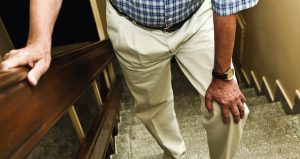

This slow rate of healing is particularly prevalent in the aging population. When an elderly person injures their knee, it is usually related to a degenerative and acute age-related disorder. And unlike trauma, or sports related meniscus tears that commonly affect younger patients, the degenerative tears related to the aging process most often will respond better to conservative treatment approaches and monitoring. That is why it’s often times essential to have ongoing medical assistance for seniors.
Symptoms, Diagnosis and Treatment
Swelling and pain in the knee are common symptoms of a meniscus tear and can be accompanied by sensations of clicking, locking, popping, catching and occasionally even giving way. After a thorough evaluation with appropriate images (X-ray/MRI), your doctor will discuss whether or not surgery is appropriate. If surgery is necessary, it is almost always done with a minimally invasive arthroscopic procedure, but often times due to other age-related illnesses and precautions, an elderly patient will be put on a pain management program and most likely will need to use a walker, cane or scooter to get around.
Long-Term Care & Assistance
With the proper diagnosis, treatment, rehabilitation and home care, most people will recover fairly well within a few months time. But with the elderly, it’s often times necessary to have the help of medical staff on an ongoing basis. At HarborChase of Sarasota, a senior home care facility, they are experts on providing for the elderly in countless capacities. If you, or a loved one have suffered a meniscus tear, or other injuries, and are finding it to be a taxing effort to maintain daily tasks, HarborChase has the skillsets to assist you in making long-term care decisions and providing you with a better quality of life, by giving you the assistance, rehabilitation and training that are often needed to help you maintain mobility.
The HarborChase Approach
HarborChase has a distinctive approach to senior care. They have a highly experienced team of professionals with a true commitment to delivering quality senior care services, while exemplifying compassion and respect. All HarborChase associates are carefully selected not only for their dedication to enrich the lives of each individual resident, but for their warm and caring hearts. HarborChase celebrates senior living each and every day.
The Five Core Values of HarborChase:
• Respect
• Our respect for one another motivates us to fully value and foster the dignity and individuality of each resident, family member and staff caregiver.
• Attentiveness
• We focus our energy and our efforts on our residents and their families. Their needs and expectations determine the services we provide. Their social, emotional and physical wellbeing inspire all we do.
• Integrity
• We commit to doing the right things for the right reasons, whether or not anyone will know.
• Stewardship
• We work to be good stewards of our own and our residents’ resources by exercising a thoughtful and responsible use of the time, skills, materials and finances over which we have been entrusted.
• Excellence
• We strive to continually exceed our customers’ expectations with outstanding service.
To find out more about HarborChase, please visit their website at, www.harborchase.com
HarborChase
5311 Proctor Rd., Sarasota, FL 34233
941-387-9070
www.harborchase.com
 Southwest Florida's Health and Wellness Magazine Health and Wellness Articles
Southwest Florida's Health and Wellness Magazine Health and Wellness Articles

